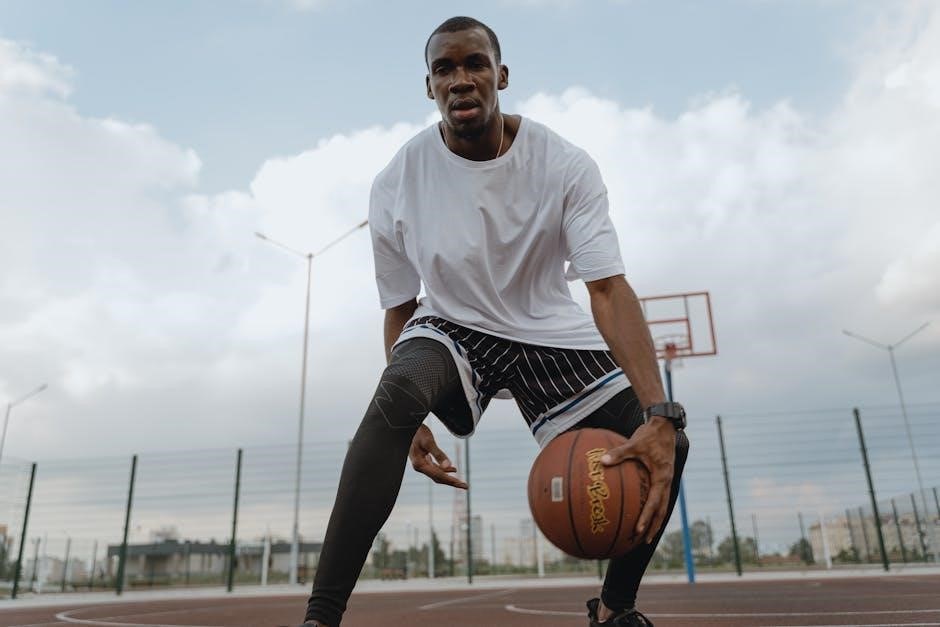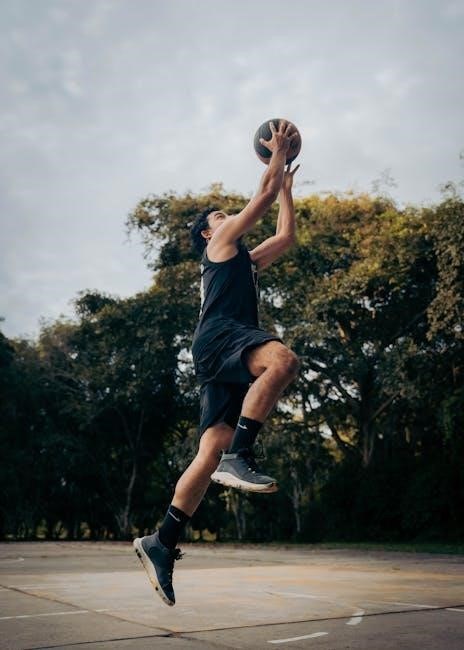A well-structured basketball pre-game warm-up is essential for preparing players physically and mentally, ensuring optimal performance and reducing injury risks. This guide outlines a comprehensive 25-30 minute routine, combining general warm-up exercises, dynamic stretching, sport-specific drills, plyometrics, and mental preparation strategies to enhance game readiness and focus.
1.1 Importance of a Proper Warm-Up
A proper basketball pre-game warm-up is crucial for enhancing performance, preventing injuries, and preparing players mentally. It increases blood flow, activates muscles, and elevates core temperature, reducing injury risks. A structured warm-up also sharpens focus, ensuring players are physically and mentally ready to excel during the game. Incorporating dynamic stretching, sport-specific drills, and plyometrics prepares athletes for the demands of basketball, fostering peak performance and confidence.
1.2 Overview of the Warm-Up Routine
A comprehensive basketball pre-game warm-up routine typically lasts 25-30 minutes, divided into key segments. It begins with a general warm-up, followed by dynamic stretching to improve flexibility. Sport-specific drills, such as ball handling and shooting, simulate game scenarios. Plyometric exercises enhance explosiveness, while mental preparation techniques, like visualization and breathing exercises, ensure focus. This structured approach ensures players are fully prepared for competition.
General Warm-Up (5-10 Minutes)
The general warm-up phase focuses on elevating core temperature, increasing heart rate, and promoting blood flow to muscles through light cardio and mobility exercises, preparing the body for more intense activity.
2.1 Light Cardio Exercises
Light cardio exercises, such as jogging, high knees, and backpedaling, are designed to gradually increase heart rate and warm up major muscle groups. These movements improve circulation, preparing the body for more intense activity while reducing the risk of early fatigue and injury. They lay the foundation for the upcoming dynamic stretches and sport-specific drills, ensuring a smooth transition into the workout.
2.2 Muscle Activation and Mobilization
Muscle activation and mobilization exercises focus on engaging key muscle groups and improving joint mobility. Techniques like leg swings, arm circles, and hip openers enhance flexibility and coordination. These movements prepare the body for dynamic movements, ensuring muscles are active and ready for the demands of basketball, while also reducing the risk of strains and improving overall range of motion during the game.

Dynamic Stretching (5-7 Minutes)
Dynamic stretching involves active movements like arm circles, leg swings, and torso twists. These exercises increase blood flow, enhance flexibility, and prepare muscles for intense activity without causing fatigue.
3.1 Upper Body Dynamic Stretches
Upper body dynamic stretches focus on movements like arm circles, shoulder rolls, and torso twists. These exercises improve flexibility, reduce muscle tension, and enhance blood flow to the chest, shoulders, and arms. Players can perform arm swings forward and backward, cross-body stretches, and high-to-low torso rotations. These movements prepare the upper body for shooting, passing, and defensive movements, ensuring optimal range of motion and reducing injury risk during the game.
3.2 Lower Body Dynamic Stretches
Lower body dynamic stretches include leg swings, lunges, and hip circles. These exercises enhance flexibility, mobility, and blood flow to the legs, hips, and calves. Players can perform high knees, butt kicks, and side-to-side shuffles. These movements prepare the lower body for explosive jumps, quick direction changes, and rapid accelerations, essential for basketball performance, while also reducing the risk of hamstring and quadriceps injuries during the game.
Sport-Specific Drills (10-12 Minutes)
Sport-specific drills focus on basketball skills like ball handling, shooting, and defensive movements. These exercises simulate game scenarios, enhancing reaction time and readiness for competition effectively.
4.1 Ball Handling Drills
Ball handling drills are designed to improve dexterity, control, and confidence. Exercises like figure-eight dribbles, crossovers, and behind-the-back dribbles prepare players for game situations. These drills enhance hand-eye coordination, speed, and precision, ensuring players can maintain possession under pressure. Incorporating high-intensity intervals with ball handling fosters focus and readiness for competitive play, elevating both individual and team performance effectively during the game. Proper technique and consistency are emphasized to maximize results.
4.2 Shooting Drills
Shooting drills are essential for improving accuracy and consistency. Players practice catch-and-shoot, off-the-dribble, and game-situation shots to simulate real-game scenarios. These exercises focus on proper form, follow-through, and mental focus. Drills like shooting lines and lay-up variations enhance muscle memory and prepare players for defensive pressure. Time-efficient shooting routines ensure readiness for varying game situations, optimizing performance under pressure. Precision and repetition are key to success.
4.3 Defensive Stance and Movement Drills
Defensive stance and movement drills refine players’ ability to guard effectively. Emphasizing proper footwork, balance, and body positioning, these exercises simulate game scenarios. Players practice sliding, shuffling, and closing out, focusing on quick reactions and maintaining defensive integrity. These drills improve agility, reaction time, and court awareness, ensuring players are ready to adapt to opponents’ offensive strategies during the game. Consistent practice enhances defensive performance.
Plyometric Exercises (5-7 Minutes)
Plyometric exercises enhance explosive power and explosiveness, crucial for basketball. Drills like box jumps, burpees, and depth jumps activate fast-twitch muscles, preparing players for high-intensity game movements efficiently.
5.1 Explosive Jumping Drills
Explosive jumping drills are vital for basketball, targeting fast-twitch muscles to boost vertical leap and power. Box jumps and depth jumps enhance explosiveness, while burpees combine strength and agility. These drills simulate game scenarios, preparing players for rapid movements and high-energy plays, ensuring they can perform at peak levels during the game.
5.2 Agility Ladder Drills
Agility ladder drills refine foot speed, coordination, and quick direction changes, essential for basketball. Exercises like high knees, lateral shuffles, and carioca drills improve agility and reaction time. These drills mimic game movements, helping players navigate the court effectively. Incorporating ladder drills into the warm-up enhances overall athleticism and court readiness, ensuring players are sharp and agile for competition.
Mental Preparation (5 Minutes)
Mental preparation sharpens focus, reduces anxiety, and enhances concentration. Techniques include visualization of game scenarios, positive affirmations, and controlled breathing exercises to calm the mind and prepare for competition.
6.1 Visualization Techniques
Visualization is a powerful tool for mental preparation. Players close their eyes and vividly imagine themselves excelling in game scenarios, such as making shots, defending, or scoring. This practice strengthens confidence, enhances focus, and prepares the mind for high-pressure situations, fostering a positive mindset and improving performance on the court by mentally rehearsing success.
6.2 Breathing Exercises for Focus
Deep breathing exercises are a simple yet effective way to enhance mental clarity and calmness before a game. Players inhale deeply through the nose, hold the breath briefly, and exhale slowly through the mouth. This practice reduces anxiety, lowers heart rate, and improves concentration, helping athletes transition from off-court distractions to a focused, game-ready mindset.

Cool-Down and Transition to the Game
The cool-down phase ensures players transition smoothly to the game, incorporating static stretching to maintain flexibility and hydration to replenish fluids, ensuring peak readiness.
7.1 Final Stretching Routine
The final stretching routine focuses on static stretches for major muscle groups, including hamstrings, quadriceps, and hip flexors, to maintain flexibility and reduce muscle tightness. This phase helps players transition smoothly into the game, ensuring they remain loose and prepared for peak performance while minimizing the risk of injury during high-intensity play.
7.2 Hydration and Final Preparations
Hydration is critical for maintaining energy and focus during the game. Players should drink water or sports drinks to replenish fluids lost during warm-up. Final preparations include uniform checks, ensuring proper footwear, and mentally transitioning into game mode. Coaches should reinforce teamwork, strategy, and mental toughness, ensuring players are fully prepared to perform at their best from tip-off.

Sample 30-Minute Pre-Game Warm-Up Routine
This structured routine includes timed segments for general warm-up, dynamic stretching, sport-specific drills, plyometrics, and mental preparation, ensuring players are fully prepared for game action.
8.1 Timed Structure for Each Segment
A well-organized 30-minute pre-game warm-up ensures optimal preparation. Allocate 5-10 minutes for general warm-up, 5-7 minutes for dynamic stretching, 10-12 minutes for sport-specific drills, 5-7 minutes for plyometrics, and 5 minutes for mental preparation. This structured approach ensures a gradual increase in intensity, elevating heart rate and preparing muscles for game demands while maintaining focus and readiness. Timing is crucial for peak performance.
8.2 Drills and Exercises Included
The warm-up routine includes a variety of drills and exercises such as light cardio, dynamic stretching, ball handling, shooting, and defensive stance work. Plyometric exercises like explosive jumps and agility ladder drills are also incorporated to enhance explosiveness and agility. These exercises are designed to prepare players physically and mentally, ensuring they are ready to perform at their best during the game.
Benefits of a Structured Warm-Up
A structured warm-up reduces injury risks, enhances flexibility, and improves performance by preparing muscles for intense activity, boosting explosiveness, and sharpening mental focus for the game.
9.1 Injury Prevention
A proper warm-up significantly reduces the risk of injuries by increasing blood flow and flexibility. It prepares muscles for high-intensity movements, minimizing strains and sprains. Dynamic stretches and muscle activations target key areas like hamstrings, quads, and calves, essential for basketball. This preparation ensures joints are lubricated and muscles are ready for explosive actions, lowering the chance of game-related injuries and promoting long-term player health.
9.2 Improved Performance
A well-executed pre-game warm-up enhances physical preparedness, mental focus, and readiness for competition. By increasing core temperature, heart rate, and blood flow, players achieve optimal physiological readiness. Dynamic stretches improve flexibility, while sport-specific drills enhance speed, agility, and reaction time. This structured approach ensures athletes perform at their peak, executing skills efficiently and responding quickly to game demands, ultimately elevating overall team performance and success.

Common Mistakes to Avoid
Overlooking mental preparation, rushing drills, and improper stretching are common pitfalls. Ensure the routine is tailored to team needs and player fitness levels to maximize effectiveness and avoid underperformance.
10.1 Rushing the Warm-Up
Rushing the warm-up is a common mistake that can lead to inadequate preparation. It reduces the effectiveness of exercises and increases injury risks. A hurried routine fails to elevate core temperature, activate muscles, and mentally prepare players. Coaches should ensure each segment is timed properly to allow gradual progression from light cardio to sport-specific drills, avoiding shortcuts that compromise readiness. Proper pacing is crucial for peak performance.
10.2 Overlooking Mental Preparation
Overlooking mental preparation is a critical error, as it leaves players unprepared for game pressures. Visualization, breathing exercises, and focus drills help narrow attention and build confidence. Neglecting this step can lead to anxiety, poor decision-making, and reduced performance. Coaches must prioritize mental strategies to ensure players enter the game calm, focused, and mentally sharp, complementing their physical readiness and enhancing overall team performance effectively.

Customizing the Routine
A successful pre-game warm-up is tailored to meet team needs, incorporating drills that address specific skills and fitness levels. Coaches should adapt routines to enhance player development and preparation, ensuring exercises align with team goals and player capabilities for optimal effectiveness and engagement during the warm-up session.
11.1 Tailoring to Team Needs
A successful pre-game warm-up should be customized to address specific team requirements, focusing on skills and strategies relevant to the upcoming game. Coaches can incorporate drills that simulate in-game scenarios, ensuring players are prepared for various challenges. By aligning the warm-up with the team’s strategic goals and player roles, coaches can enhance overall performance and readiness, making the routine both effective and engaging for all athletes involved. This tailored approach ensures optimal preparation and focus, helping the team achieve its objectives during the game.
11.2 Adjusting for Player Fitness Levels
Coaches should modify the warm-up routine to accommodate varying player fitness levels, ensuring each athlete is challenged appropriately without risking overexertion. Less intense exercises can be substituted for high-impact drills, while fitter players may engage in more rigorous activities. This personalized approach promotes inclusivity and safety, allowing all team members to prepare effectively for the game, regardless of their fitness level. This ensures a balanced and productive warm-up session for everyone involved. Proper adjustments help prevent injuries and cater to individual needs, fostering a cohesive and prepared team environment. The goal is to maximize each player’s potential while maintaining overall team readiness and focus. By tailoring the warm-up to fitness levels, coaches can optimize performance and ensure all players are mentally and physically prepared for competition. This adaptive strategy is key to a successful pre-game routine, enhancing both individual and team success. The warm-up should be dynamic, yet considerate of each player’s capabilities, to achieve the best possible outcomes. Balancing intensity with inclusivity ensures that every player contributes effectively to the team’s goals. This method not only prevents injuries but also builds confidence and camaraderie among team members. A well-adjusted warm-up routine is essential for peak performance and overall success in basketball. By considering fitness levels, coaches can create a routine that benefits all players, leading to a more unified and prepared team. This approach underscores the importance of adaptability in coaching, ensuring that no player is left behind or overextended. The result is a warm-up that is both effective and equitable, setting the team up for success. Coaches must remain vigilant in assessing player fitness and adjusting the routine accordingly, making it a cornerstone of their pre-game strategy. This ensures that every player enters the game in optimal condition, ready to perform at their best. The combination of tailored exercises and a focus on individual needs creates a powerful pre-game warm-up that drives team success and minimizes risks. By prioritizing player fitness levels, coaches can craft a routine that is both challenging and safe, ensuring all athletes are prepared to excel. This thoughtful approach to warm-ups is vital for achieving peak performance and maintaining player well-being. Coaches who adapt their routines to fitness levels foster a positive and productive team culture, leading to greater cohesion and success on the court. The ability to adjust the warm-up to meet individual needs is a hallmark of effective coaching, ensuring that every player is ready to contribute to the team’s objectives. This strategy not only enhances performance but also strengthens team unity, creating a foundation for long-term success. By focusing on player fitness levels, coaches can design a warm-up that is both impactful and inclusive, driving the team toward its goals with confidence and preparedness. This adaptive approach is essential in modern basketball, where every player’s role is crucial to overall success. Coaches who embrace this method demonstrate a commitment to excellence and player development, ensuring that the warm-up is a powerful tool for achieving victory. The integration of fitness-based adjustments into the pre-game routine is a testament to the evolution of coaching strategies, aimed at maximizing potential and minimizing risks. This forward-thinking approach ensures that every player is valued and prepared, contributing to a cohesive and high-performing team. By addressing individual fitness levels, coaches can unlock the full potential of their squad, leading to greater achievements and a stronger team identity. The warm-up becomes not just a routine, but a catalyst for success, tailored to the unique needs of each player. This mindset of adaptability and inclusivity is the key to dominating the competition and achieving lasting success in basketball. Coaches who master this art set their teams apart, creating a legacy of excellence and preparedness that resonates throughout the season. The ability to adjust the warm-up to player fitness levels is a critical skill, ensuring that every athlete is ready to perform at their peak. This personalized approach fosters a culture of excellence, where every player feels valued and empowered to contribute. The result is a team that is not only prepared but also united, ready to face any challenge the game presents. By focusing on individual fitness levels, coaches can create a warm-up that is both effective and inspiring, driving the team toward greatness. This tailored method ensures that no player is overlooked, and every athlete has the opportunity to shine. The warm-up becomes a powerful tool for building confidence and cohesion, essential elements for any successful basketball team. Coaches who adopt this strategy demonstrate a deep understanding of their players’ needs, leading to a more motivated and prepared squad. The integration of fitness-based adjustments into the warm-up routine is a cornerstone of modern coaching, ensuring that every player is ready to excel. This approach not only enhances performance but also strengthens the bond between players and coaches, creating a winning environment. By considering each player’s fitness level, coaches can design a warm-up that is both challenging and safe, setting the stage for a successful game. This thoughtful strategy is vital for achieving peak performance and maintaining player well-being, making it an indispensable part of any pre-game plan. Coaches who prioritize player fitness levels in their warm-up routine demonstrate a commitment to excellence and player development, ensuring that every athlete is prepared to contribute to the team’s success. This adaptive approach is essential in today’s competitive basketball landscape, where every detail matters. By tailoring the warm-up to individual needs, coaches can unlock the full potential of their team, leading to greater achievements and a stronger team identity. The warm-up becomes a catalyst for success, driving the team toward victory with confidence and preparedness. This mindset of adaptability and inclusivity is key to dominating the competition and achieving lasting success. Coaches who master this art set their teams apart, creating a legacy of excellence that resonates throughout the season. The ability to adjust the warm-up to player fitness levels is critical, ensuring that every athlete is ready to perform at their peak. This personalized approach fosters a culture of excellence, where every player feels valued and empowered to contribute. The result is a team that is prepared, united, and ready to face any challenge, setting the stage for a successful game.

PDF Guide and Resources
Download our comprehensive Basketball Pre-Game Warm-Up PDF Guide, featuring detailed 30-minute routines, drills, and exercises. Additional resources include expert tips, videos, and customizable templates to enhance your preparation.



